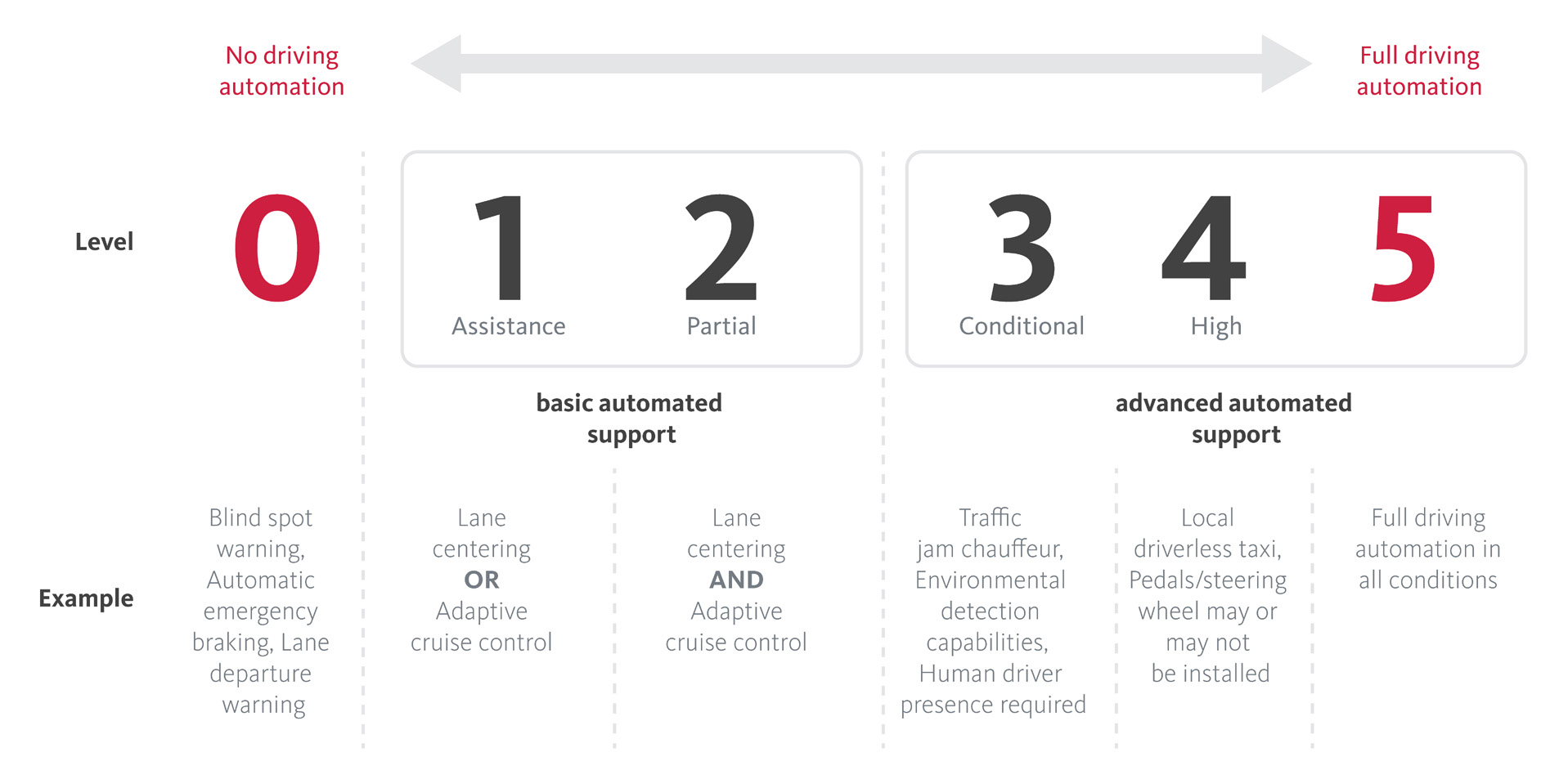Author(s):
Michael Fekete, Zain Hemani, Sam Dobbin
Nov 21, 2023
Introduction
Comprehensive regulations must be in place before fully automated, driverless vehicles (AVs) can occupy Canadian roadways. A regulatory framework is beginning to emerge in Canada, with initial federal and provincial guidelines drawing on standards set by the Society of Automotive Engineers (SAE) International.
SAE standards
The SAE has defined six levels of driving automation, ranging from no automation to full automation:
- Level 0: no driving automation
- Level 1: driver assistance
- Level 2: partial driving automation
- Level 3: conditional driving automation
- Level 4: high driving automation
- Level 5: full driving automation

Each level refers to the functions and degree of control the driving automation system can perform. Level 1 includes basic automated support such as adaptive cruise control. Higher levels, such as Level 4, include advanced systems that would be capable of driving without human intervention in most conditions and in limited geographic areas.
As a general point of reference, AVs classified as Levels 0, 1, and 2 always require human oversight and intervention, while Levels 3, 4, and 5 are “self-driving” in varying forms.
Federal framework
The federal government regulates the manufacturing and importation of motor vehicles in Canada through the Motor Vehicle Safety Act (MVSA). The MVSA sets out specific technical standards and licensing requirements applicable to all motor vehicles.
To promote self-driving technology and safety features, in 2018 the MVSA was amended to add limited exemptions for AVs meeting certain standards. The federal government (through Transport Canada and the Canadian Council of Motor Transportation Administrators) has also created a set of guidelines, which are linked below.
Transport Canada
Canadian Council of Motor Transportation Administrators
The Canadian Council of Motor Transportation Administrators has released its own guidelines that consider the roles and responsibilities of government, testing and deployment of AVs, law enforcement, safety and research.
Provincial frameworks
In contrast to the federal framework (which create safety regulations for vehicles sold within or imported into Canada), provinces and territories are responsible for regulating drivers, insurance, liability, vehicle maintenance, and traffic laws within their jurisdiction. Although there is not yet a widely adopted approach to regulating AVs across provinces and territories, some provinces have taken steps to encourage innovation by approving pilot programs and trials to test AVs on public roads.
The provinces that have taken formal steps to allow for testing of AVs include Ontario, Québec, Nova Scotia and Manitoba.
ONTARIO:
Ontario’s regulation of AVs falls under the scope of The Highway Traffic Act, with the Ministry of Transportation’s Automated Vehicle Pilot Program serving as the guiding
framework.
Ontario was the first province to launch a pilot program in 2016 (updated in 2019) which allows AVs at SAE levels 3–5 to be tested on Ontario’s roads if strict conditions are met. Organizations eligible to apply for this program include:
- auto manufacturers
- other manufacturers of parts, systems, or equipment
- technology companies
- academic institutions
MANITOBA:
Manitoba’s Vehicle Technology Testing Act, allows for a “test vehicle” to be operated with or without the engagement of an automatic driving system with a “technology testing permit”.
QUEBEC:
In Québec, the public is permitted to operate AVs at SAE Level 3, provided the vehicles are legally authorized for sale and purchase within Canada.
NOVA SCOTIA:
In Nova Scotia, the Traffic Safety Act is awaiting royal proclamation. Once in force, the amendments will enable insurance mandates to be set out for AVs.
What to expect
We expect there to be further use of AV technologies in Canadian testing and pilot programs as these technologies continue to be developed and refined. In further regulating AV technologies, Canada may look to other jurisdictions for guidance such as the United Kingdom, which is in the process of introducing legislation to regulate the safe use of autonomous vehicles.